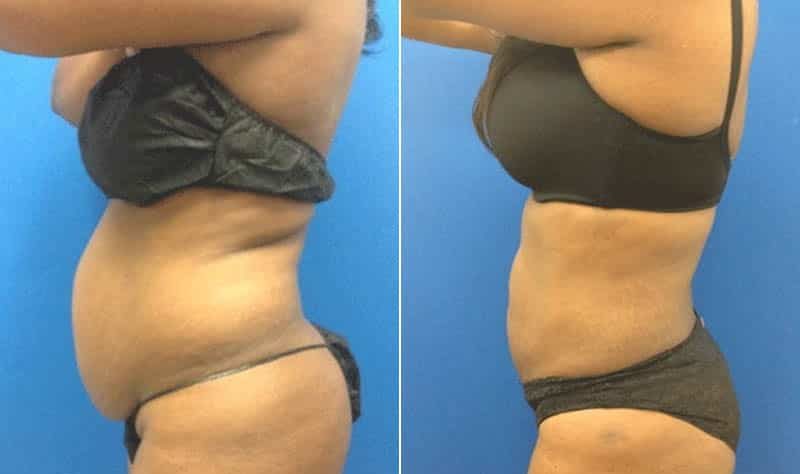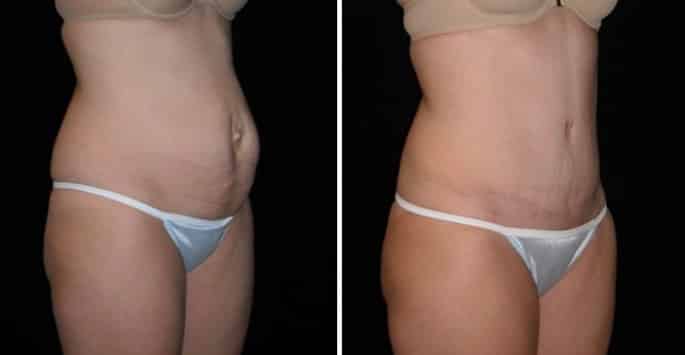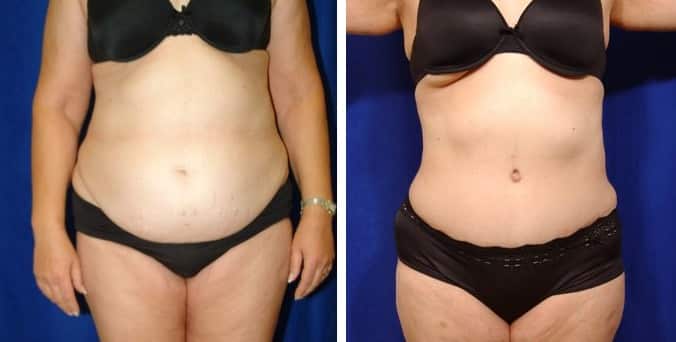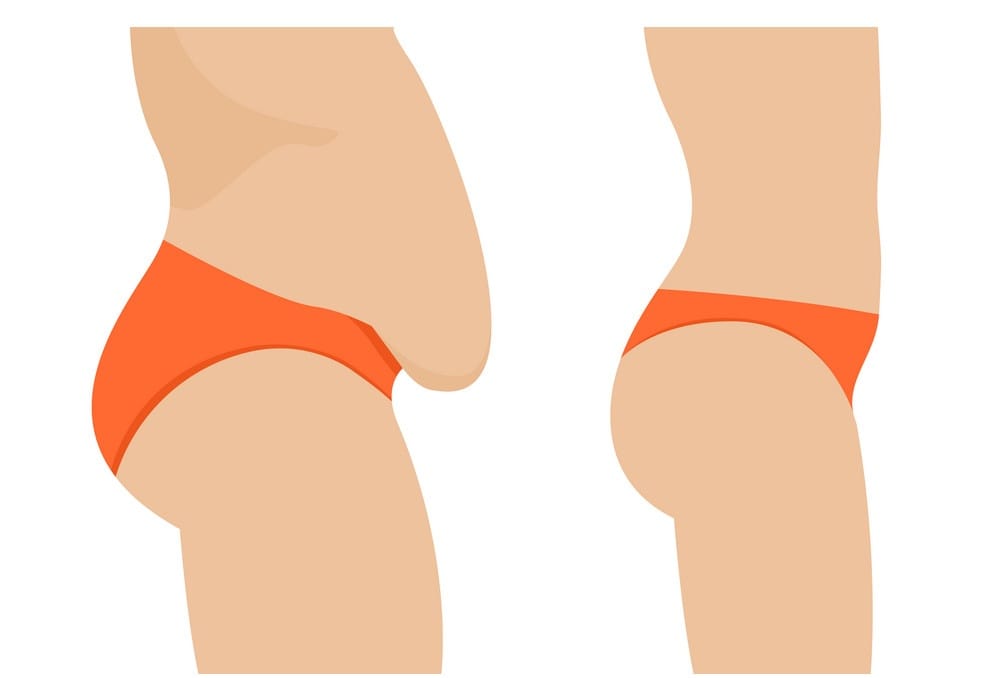







Summary of Tummy Tuck
- Duration of procedure: 2-3 hours
- Duration of hospital stay: Day care procedure
- Need of follow-up: Once or twice
- Stitch removal: No
- Cost: Rs.75000 onwards (plus taxes & pressure garment)
Abdominoplasty / Tummy Tuck Surgery is suitable for patients who present skin flabbiness and excess of abdominal wall fat. It is recommended especially for women following pregnancy. Pregnancy, besides distending the skin and the abdominal muscles, promotes accumulation of fat in the abdominal area, which is not usually eliminated with diets or physical exercises.
The abdominoplasty involves excision of excess abdominal wall fat and skin followed by recontouring and tightening of the abdomen. It can be accompanied by liposuction of the adjacent areas.
Shortly after the surgery, bruises and a relative insensibility in some areas are common, which are relieved with the regular use of an elastic compression garment which is recommended for 4-6 weeks. Stitches are removed usually on the 7th to the 15th day. The time of surgery is usually of 3 hours, and of the hospitalization is 24 hours. Abdominoplasty can also be combined with the lower body lift.
Tummy Tuck Surgery
(Abdominoplasty)
Many have loose abdominal skin and fat that is concentrated in the abdomen and hence can benefit from abdominoplasty. Sometimes these conditions are inherited. In other instances, substantial weight loss may cause abdominal skin to become flaccid. Abdominoplasty also can tighten muscles that have been separated and weakened by pregnancy. The procedure may somewhat improve the appearance of stretch marks, especially those located below the navel.
Your Personal Consultation
During the consultation, you will be asked about the results you would like to achieve from abdominoplasty. This will help your surgeon to understand your expectations and determine whether they realistically can be achieved.
Am I a good candidate for abdominoplasty?
You may be a good candidate for abdominoplasty / Tummy Tuck Surgery if you have one or more of the following conditions:
- excess or sagging abdominal skin
- an abdomen that protrudes and is out of proportion to the rest of your body
- abdominal muscles that have been separated and weakened
- excess fatty tissue that is concentrated in your abdomen
If you plan to become pregnant or lose weight in the future, you should discuss this with your plastic surgeon. Scarring from previous abdominal surgery may limit the results of your abdominoplasty.
Will my insurance help cover the cost of surgery?
Abdominoplasty, as an aesthetic (cosmetic) procedure, generally is not covered by insurance. In some instances, however, a patient may have a hernia and not just a spreading of the abdominal muscles. Insurance reimbursement may be available for that portion of the procedure that is not cosmetic.
Many factors determine your eligibility for coverage, including the specific terms of your insurance policy. A letter of predetermination may be required by your insurance company prior to surgery. Your
tummy tuck surgery Surgeon
or a staff member in your surgeon’s office will discuss these matters with you. Contura Cosmetic is one of the top
Abdominoplasty surgery hospital in Bangalore.
How Abdominoplasty Is Performed
Individual factors and personal preferences will determine the specific technique selected to smooth and flatten your abdomen.
Where are the incisions placed?
Generally, a horizontal incision is placed just within or above the pubic area. The length of the incision, which extends laterally toward the pelvic bones, depends largely on the amount of skin to be removed. The contour of this incision will vary somewhat according to the structure of your abdomen and the style of bathing suit or undergarments that you prefer. Your plastic surgeon will try to keep the incision within your bathing suit lines, but this may not always be possible.
Generally, a horizontal incision is placed just within or above the pubic area. If there is loose skin above the navel, the surgeon may make a second incision around the navel. Skin in the shaded area is separated from the abdominal wall.
Some patients have loose skin above the navel. In such cases, the surgeon may make a second incision around the navel so that the redundant skin above it can be pulled down. The excess abdominal skin is then removed. The position of the navel remains unchanged.
To tighten the abdominal wall, the surgeon brings loose underlying tissue and muscle together with sutures.
Skin of the lower abdomen that contains stretch marks may be removed as well. Any remaining stretch marks may be somewhat flattened and improved, but you should not expect a dramatic change in their appearance.
The procedure may include tightening of the underlying abdominal muscles using sutures.
Understanding Risks
Fortunately, significant complications from abdominoplasty are infrequent. Every year, many thousands of people undergo successful aesthetic surgery of the abdomen, experience no major problems and are pleased with the results. Anyone considering surgery, however, should be aware of both the benefits and risks.
How should I prepare for surgery?
If you are a smoker, you will be asked to stop smoking well in advance of surgery. Aspirin and certain anti-inflammatory drugs can cause increased bleeding, so you should avoid taking these medications for a period of time before surgery. Your surgeon will provide you with additional preoperative instructions.
Abdominoplasty may be performed on an outpatient basis. If this is the case, be sure to arrange for someone to drive you home after surgery and to stay with you for at least the next day or two. When abdominoplasty is performed in conjunction with medically necessary procedures such as hysterectomy or hernia repair, a short hospitalization may be required.
When can I resume my normal activities?
It is important to realize that the amount of time it takes for recovery varies greatly among individuals. Depending on the extent of your abdominoplasty and your general physical condition, you may be able to return to non-strenuous work anywhere from one to three weeks after surgery.
In many instances, you can resume most of your normal activities, including some form of mild exercise, after a few weeks. You may continue to experience some mild, periodic discomfort and swelling during this time, but such feelings are normal. Severe pain should be reported to your doctor.
Any sexual activity should be avoided for a minimum of two weeks, and your plastic surgeon may advise you to wait longer.
Results of Your Abdominoplasty
Abdominoplasty will enhance your body contour by making your abdomen firmer and flatter. You may find that you feel more comfortable in your clothing and are more confident about your appearance.
The incisions from the procedure will heal and fade over time. It is important to realize, however, that the incision lines will be permanently visible. In some instances, they will eventually be only faint lines. Certain individuals may have incision lines that are more noticeable. Fortunately, the incisions for your abdominoplasty are usually in locations concealed by most bathing suits and undergarments.
How long will the results last?
Unless you gain or lose a significant amount of weight or become pregnant, your abdomen should remain firmer and flatter for many years. However, gravity and the effects of aging will eventually take their toll. If, after a period of years, you again become dissatisfied with the appearance of your abdomen, you may choose to undergo a second procedure to restore a more youthful body contour.
For more info, check out our other Tummy Tuck pages:
What happens on Tummy Tuck day?


